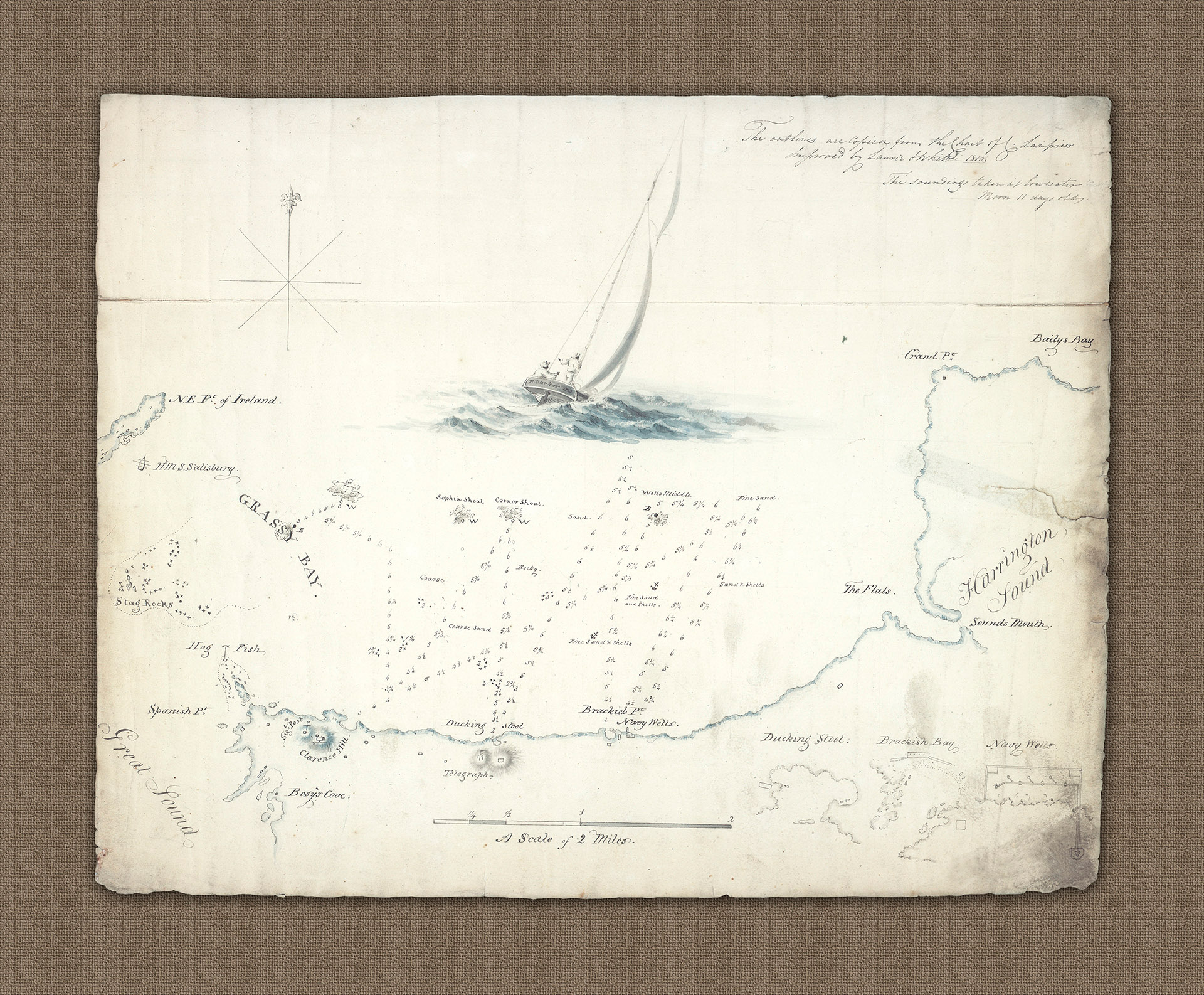
A606 - Bermuda, Spanish Point to Bailys Bay
This beautifully presented survey of the coastline from Spanish Point to Bailys bay in Bermuda complements a second survey of Great Sound (see A605). This survey includes the hand-written inscription; 'The outlines are copied from the chart of C Lempriere, improved by Laurie and Whittle, 1810'...'The soundings taken at low water. Morn 11 days old'. It is reasonable to assume that this survey was completed within days of the survey of Great Sound - June 23rd 1823.
- 1823
- P. Parker
- h16.5" x w19.5"
- L
As with the Great Sound survey (Heritage Charts A605), a beautiful water-colour inset of a sailing vessel is included, but unlike the one depicted on the Great Sound chart this ship is sailing relatively calm waters. This survey clearly has a lot of detail in common with the survey of Wells Anchorage (Heritage Charts A604).
Once again, the stern of the ship bears the author's name 'P. Parker 1823' which raises the question is whether the P. Parker in question as author of this little survey was in fact Peter Parker, 3rd Baronet (1809-1835). Coming from a very long line of Parkers who served in the British navy he would have been a young man of about 14yrs in the service around the time this suvey was made in 1823. He was promoted to Leiutenant in 1829 and Commander in late 1834 at the age of just 25. He died in 1835 after a short illness. It is certainly the sort of meteoric rise through the ranks as befits a member of Britain's foremost Naval family.
The survey is very detailed and covers the coastline and area of water to the north east of Great Sound from Spanish point to Bailys Bay, Pembroke. The hydrography and soundings all deal with the channels into four vital naval installations on the north coast of Pembroke: the bay under Admiralty House on Clarence Hill known at the time (but oddly not marked on this survey) as 'Clarence Cove'; the bay known as Ducking Stool; the bay at Brackish point; the Naval Wells next to Brackish Point.
To emphasise the importance of the latter three installations, this survey includes an inverted plan of each as they would be approached from the sea. It is well worth noting the engineering of the fresh-water wells. Other hydrographic information included is the definition of sand type - coarse, fine, sand with shells - on the sea bed along with reefs and rocks. Points of anchorage are marked in the bay which was also known as 'Wells Anchorage'. HMS Salisbury, the flagship of Rear Admiral Sir William Charles Fahie, is marked at anchor off Irish Island at the Naval Dockyard (see also B105).
Fahie was the senior British Naval Officer on the Island and was in command of the North American Station which controlled the Atlantic off the coast of North America and protected British trade lines to and from the remaining British colonies in the Caribbean.
The Commander of HMS Salisbury at this time was Captain William Maude. It was to Captain Maude that Parker, according to hand-written an inscription on the back of the original survey, delivered the finished surveys on 2nd January 1824. The fact that this was a full eight months after the surveys were completed is slightly odd but may be explained by an entry which appeared in the Montreal Herald on Wednesday August 13th 1823 which stated that HMS Salisbury had sailed into port in Quebec on the previous Sunday carrying Fahie and his new wife. It is possible that Parker was unable to present the surveys before Captain Maude and HMS Salisbury had left for Canada and had to wait for their return in January of the following year.
Although there is very little cartographic detail included in the survey, individual buildings around the coast and on the islands, presumably of strategic importance, are shown. These include the naval dockyard on Ireland Island along with the signal posts on Clarence Hill and on the hill above Ducking Stool. The house which became known as Admiralty House was a gift from the Bermuda Government to the Royal Navy in about 1814 having been purchased at a cost of £3,000. It was gifted for the use of the senior naval officer on the Island. Following its purchase the name of the hill upon which it stood which was changed from St. John's Hill to Clarence Hill, in honor of His Royal Highness the Duke of Clarence (it is now St. John's Hill again).
The bay below it also had a name change, from Abbott's Bay (after Sir Maurice Abbott, Governor of the East India Company) to Clarence Cove. The reference to the use of Lampriere's chart of 1810 is important as it places that chart as the definitive source of cartographic information about the Islands as late as 1823. Thomas Hurd's more exacting and accurate chart of 1788-1797 (see A603a & A603b) was not published at the time by the Admiralty, although it was eventually reduced, copied and issued in a reduced form (see A607), in October 1827.
- Bermuda, Spanish Point to Bailys Bay


